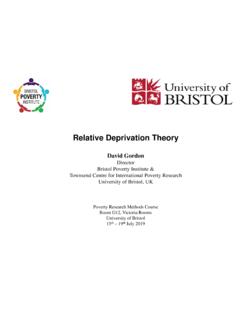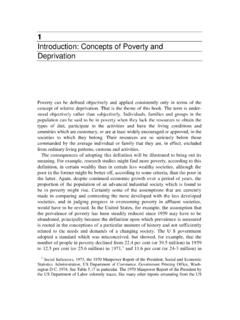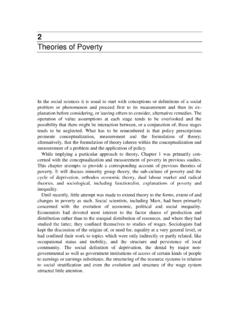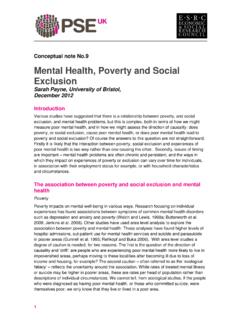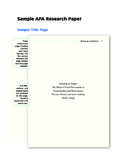Transcription of 1 Introduction: Concepts of Poverty and Deprivation
1 1 introduction : Concepts of Poverty and Deprivation Poverty can be defined objectively and applied consistently only in terms of the concept of relative Deprivation . That is the theme of this book. The term is under-stood objectively rather than subjectively. Individuals, families and groups in the population can be said to be in Poverty when they lack the resources to obtain the types of diet, participate in the activities and have the living conditions and amenities which are customary, or are at least widely encouraged or approved, in the societies to which they belong. Their resources are so seriously below those commanded by the average individual or family that they are, in effect, excluded from ordinary living patterns, customs and activities. The consequences of adopting this definition will be illustrated to bring out its meaning.
2 For example, research studies might find more Poverty , according to this definition, in certain wealthy than in certain less wealthy societies, although the poor in the former might be better off, according to some criteria, than the poor in the latter. Again, despite continued economic growth over a period of years, the proportion of the population of an advanced industrial society which is found to be in Poverty might rise. Certainly some of the assumptions that are currently made in comparing and contrasting the more developed with the less developed societies, and in judging progress in overcoming Poverty in affluent societies, would have to be revised. In the United States, for example, the assumption that the prevalence of Poverty has been steadily reduced since 1959 may have to be abandoned, principally because the definition upon which prevalence is measured is rooted in the conceptions of a particular moment of history and not sufficiently related to the needs and demands of a changing society.
3 The U S government adopted a standard which was misconceived, but showed, for example, that the number of people in Poverty declined from per cent (or million) in 1959 to per cent (or million) in 1971,1 and per cent (or 24-3 million) in 1 Social Indicators, 1973, the 1970 Manpower Report of the President, Social and Economic Statistics Administration, US Department of Commerce, Government Printing Office, Wash-ington D C, 1974. See Table in particular. The 1970 Manpower Report of the President by the US Department of Labor solemnly traces, like many other reports emanating from the US 32 Poverty IN THE UNITED KINGDOM Students of income distribution in the United States were coming to appreciate by the late 1970s that the standard was seriously The definition also has implications for policy which should be recognized at the outset.
4 Although all societies have ways of identifying and trying to deal with their problems, the social sciences are having an increasing influence upon decision-makers, both in providing information and implicitly or explicitly legitimating action. An important example in the history of the formulation of social policies to deal with Poverty is the definition of the subsistence standard in the Beveridge Report of 1942. Beveridge adapted the definition used in measuring Poverty by Seebohm Rowntree, A. L. Bowley and others in their studies of different communities in Britain, and he argued that this was the right basis for paying benefits in a social security scheme designed to abolish For thirty years the rationale for the level of benefits paid in the British schemes of national insurance and supplementary benefit (formerly National Assistance) has rested upon the arguments put forward in the early years of the Second World War.
5 No attempt has yet been made to present an alternative rationale, although benefits have been increased from time to time in response to rises in prices and wages. A clear definition allows the scale and degree as well as the nature of the problem of Poverty to be identified, and therefore points to the scale as well as the kind of remedial action that might be taken. Such action may involve not just the general level of benefits, for example, but revision of relativities between benefits received by different types of family. Previous Definitions of Poverty Any attempt to justify a new approach4 towards the definition and measurement of government, and also papers and books by social scientists, the fall in Poverty during the 1960s and early 1970s.
6 But since a fixed and not an up-dated Poverty line has been applied at regular intervals, this fall is scarcely surprising. The same trend could have been demonstrated for every industrial society in the years since the war and, indeed for nearly all periods of history since the Industrial Revolution. 1 The Measure of Poverty , A Report to Congress as Mandated by the Education Amendments of 1974, US Department of Health, Education and Welfare, Washington DC, April 1976, p. 13. 2 Schorr, A. L. (ed.), Jubilee for our Times: A Practical Program for Income Equality, Columbia University Press, 1977, pp. 15-16. 3 Social Insurance and Allied Services (The Beveridge Report), Cmd 6404, HMSO, London, 1942. 4 It is new only in the sense that the implications and applications do not appear to have been spelled out systematically and in detail.
7 The line of thought has been put forward by many social scientists in the past. For example, Adam Smith wrote, By necessaries I under stand, not only the commodities which are indispensably necessary for the support of life, but whatever the custom of the country renders it indecent for creditable people, even of the lowest order, to be without. He gave as examples linen shirts and leather shoes which the established rules of decency have rendered necessary to the lowest rank of people . However, beer and ale, in Great Concepts OF Poverty AND Deprivation 33 Poverty , so that its causes and means of alleviation may be identified, must begin with previous definitions and evidence. The literature about both Poverty and inequality are closely related and need to be considered in turn. Any explanation of the fact that the poor receive an unequal share of resources must be related to the larger explanation of social inequality.
8 We will consider definitions, evidence about Poverty and related evidence about inequality. Previous operational definitions of Poverty have not been expressed in thoroughgoing relativist terms, nor founded comprehensively on the key Concepts of resources and style of living. The concern has been with narrower Concepts of income and the maintenance of physical efficiency. Among the early studies of Poverty , the work of Seebohm Rowntree is most important. In 1899 he collected detailed information about families in York. He defined families whose total earnings are insufficient to obtain the minimum necessaries for the maintenance of merely physical efficiency as being in primary Poverty .1 Making shrewd use of the work of W. O. Atwater, an American nutritionist, reinforced by the findings of Dr Dunlop, who had experimented with the diets of prisoners in Scotland to find how nutritional intakes were related to the maintenance of body weight, he estimated the average nutritional needs of adults and children, translated these needs into quantities of different foods and hence into the cash equivalent of these foods.
9 To these costs for food he added minimum sums for clothing, fuel and household sundries according to size of family. The Poverty line for a family of man and wife and three children was 17s. 8d. per week, made up of 12s. 9d. for food, 2s. 3d. for clothing, 1s. 10d. for fuel and 10d. for household sundries. Rent was treated as an unavoidable addition to this sum, and was counted in full. A family was therefore regarded as being in Poverty if its income minus rent fell short of the Poverty line. Nearly all subsequent studies were influenced deeply by this application of the concept of subsistence. With minor adaptations, a stream of area surveys of Poverty based on Rowntree s methods was carried out in Britain, especially be-tween the Rowntree himself carried out further studies in York in 1936 and Britain, and wine, even in the wine countries, were not necessaries because custom nowhere renders it indecent for people to live without them.
10 See The Wealth of Nations, Ward, Lock, London, 1812, p. 693 (first published 1776). 1 Rowntree, B. Seebohm, Poverty : A Study of Town Life, Macmillan, London, 1901. Charles Booth s major work in London between 1887 and 1892 was on a larger scale but employed a cruder measure of Poverty . See his Life and Labour of the People in London, Macmillan, London (17 volumes published in 1903; first volume on East London originally published 1889). 2 See, for example, Bell, Lady F., At the Works, Nelson, London, 1912; Davies, M., Life in an English Village, London, 1909; Reeves, P., Round About a Pound a Week, London, 1914; Bowley, A. L., and Burnett-Hurst, A. R., Livelihood and Poverty , A Study in the Economic and Social Conditions of Working Class Households in Northampton, Warrington, Stanley, Reading (and Bolton), King, London, 1915; Bowley, A.
